What is Sync.com?
Sync.com is a cloud storage service similar to Google Drive, OneDrive, Dropbox, Box, pCloud, IDrive, etc. You can store your files and documents securely on Sync’s servers and access them from anywhere in the world by simply logging into your account through any browser.
Unlike other cloud storage providers, Sync.com prides itself on providing end-to-end zero-knowledge encryption, which means that you and only you can decrypt the files. Not even Sync.com’s employees can do that.
Sync.com has carved a niche for itself in the cloud storage world by offering something that other competing businesses do not provide. It provides zero-knowledge encryption out of the box. Of course, comes with great features that you are going to love, but again, there are some shortcomings as well.
It comes with a very competitive pricing structure that doesn’t scare you away. Like every other cloud storage provider, Sync.com provides a free tier storage option as well, where you will get 5 GB of storage. It will remain free forever, period.
While 5GB is not really a big number for the free plan, you need to consider the fact that it makes up for that by providing end-to-end encryption that others do not provide.
Of course, Sync.com is not perfect. Nothing in this world is. For instance, Sync.com is not really great for collaboration, and the syncing speed is slow. Those are the costs you need to pay for end-to-end encryption.
But these minor quibbles aside, there are a lot of fascinating features that make Sync.com one of the finest cloud storage services available today.
Let me walk you through my experience with Sync.com. I will conclude by telling why I recommend Sync.com to anyone looking for a cloud storage solution.
Do remember that if you try to compare services like Sync.com with those of the likes of Wasabi, it will be an incorrect comparison. Wasabi operates on a mega scale and caters mostly to corporates. That doesn’t mean you cannot use it. Yes, you can!
But it has limited features and works as object storage. It competes with Amazon AWS, Microsoft Azure, Google Cloud, VMware Cloud, etc.
Sync.com, on the other hand, is a great option for personal use. It comes with options like the ability to view office documents and PDFs from the web interface, sharing capabilities, file versioning, no file size limit, and more.
So, without further ado, let’s begin…
Pros and Cons of Sync.com
As I said earlier, there is nothing in this world that is perfect. Sync.com has its strengths and weaknesses too. Here is a list of the pros and cons of this cloud storage service:
The Pros of Sync.com
- The service offers zero-knowledge encryption by default, making it one of the safest cloud storage options if you are worried about your privacy.
- There is no limit to the file size that you store. However, the size of a file should never exceed the storage space available to you.
- It offers a file versioning feature that will allow you to roll back your files up to 365 days.
- You can create a vault that will let you store data outside the sync folder. The vault is a cold storage folder. The files you keep here will stay in it even if you delete the files from the source (your device).
- It provides in-transit and at-rest encryption for your files. The encryption tech used by Sync.com is the AES 256-bit protocol.
- It allows both folder syncing and file syncing.
- It has provisions for file and folder sharing with the ability to set sharing link passwords and expiry dates.
The Cons of Sync.com
- It has limited collaboration capabilities.
- The syncing of files and folders is a bit slow because of on-the-fly syncing.
- It doesn’t have a media playback feature like its competitor pCloud.
- It doesn’t offer live chat support – something that would have been a great option, especially for organizations.
- The company doesn’t offer any option for a monthly payment plan. You have to purchase a yearly plan, which might be a little bit heavy on individuals.
- The interface is not so polished. They could have done a better job in this department. Nonetheless, the interface is completely functional.
The Incredible Features of Sync.com
Sync.com offers some amazing features that make it a great cloud storage option. Here is the set of features that you will find interesting.
Zero-Knowledge Encryption
Sync.com’s competitor, like pCloud, offers zero-knowledge encryption, but at an extra cost. In the case of Sync.com, this is a default option irrespective of whether you are on a paid plan or the free plan. This is a great feature because of multiple reasons.
First thing first, once you have zero-knowledge encryption, even Sync.com (its employees) cannot access your files without the encryption key that will be known to you. This means that even if the government or a rogue hacker gets hold of Sync.com’s server where your data resides, they cannot do anything.
This is a great feature for those who are concerned about privacy. Many people show concern over the fact that Sync.com’s server is located in Canada. Canada is a member of the 5 Eyes alliance, which is known for intruding into people’s privacy by conducting mass surveillance. The member countries of the alliance can force companies operating in their jurisdiction to handover customer data.
With zero-knowledge encryption, even if the government gets your data, they cannot do anything because they cannot decrypt it. You will hold the key to decryption/
File Versioning
Editing documents frequently is quite normal for everyone. What if you want a previous version of the document, and it never crossed your mind to keep a backup of the previous version?
This situation bugs me quite often! That’s where Sync.com’s file versioning comes in handy. It will store previous versions of your files. You can restore the previous versions anytime you want.
However, do note that if you are using a free account, you will get file versioning for up to 30 days only. By upgrading to the Pro Solo Basic account, you can get file versioning for up to 180 days. For all other plans, Sync.com offers file versioning for up to 365 days.
File versioning is also important because no one can guarantee that ransomware will never hit him or her. Ransomware attacks will encrypt your data files and ask for money to decrypt them. So, it is better that you have a backup of different versions. In case of a ransomware attack, you can retrieve an older version of the file and work on it instead of paying money.
However, one thing that you need to know about file versioning of Sync.com is that file versioning will work only on a file-by-file basis. Full account rewind is not possible (that is possible in pCloud).
The good thing is that despite Sync.com doesn’t allow full account rewind; you can get the folder to restore. If you need bigger restores, you can always contact Sync.com. They provide that support.
No Limit on File Size
Google Drive will allow files as big as 5TB. Microsoft OneDrive will allow files that are up to 100GB in size. What if you have a file size bigger than that? Sync.com will put no restriction on the file size.
No matter how big your files are, you can happily upload them to Sync.com. Just remember that your file size should not exceed the storage space allowed for your account type.
Sync Vault
The Sync Vault is a unique feature. It is a cold storage vault that will allow you to lock away some files on Sync.com servers and prevent them from getting synced across all devices.
This particular feature is a great option.
Your devices may be running out of space. You may need to clear up space, but you still want those files to be available to you, but not across all devices.
You can put them in the Sync Vault and delete the files from your device. The files will stay locked on the Sync.com server, accessible from the web interface.
Sync.com Pricing Structure
You can use Sync.com for free – forever! The free plan will give you 5GB of storage. However, you can increase the storage to up to 20GB by undertaking several actions like installing the mobile app, inviting others, etc. But 20GB is the maximum you can go.
Of course, you get access to all features that Sync.com has to offers. The file versioning feature will be limited only to 30 days.
If you want to upgrade, there are plenty of options available. Here is a complete list of pricing plans that you get with Sync.com:
Personal Mini
This plan will give you 200 GB space with 200 GB data transfer per month. The file versioning option available will allow you to recover older versions of files up to 60 days. This plan comes with a price of $5 a month, but you have to pay upfront for an entire year.
Personal Solo Basic
This plan will give your 2000 GB or 2 TB of storage space with unlimited data transfer. File versioning is available for 180 days; that is, you can recover older files that are up to 180 days old. The price for this plan is $8 a month, but you have to pay upfront for an entire year.
Pro Solo Standard
Under this plan, you will get up to 3000 GB or 3 TB of storage space with no limitation on data transfer. File versioning will work for 365 days. This, too, is a yearly plan where you have to pay for one full year in advance at the rate of $10 a month.
Pro Solo Plus
This yearly plan will cost you $15 a month. You have to pay upfront for an entire year. The storage space you get under this plan is 4000 GB or 4 TB with no cap on data transfer. File versioning will allow you to recover files that are up to 365 days old.
Pro Teams Standard
This is a plan designed for businesses. It will provide 1000 GB or 1 TB of space for each user. The maximum number of users you can add to this plan is 100. With no data transfer cap and 365-day file versioning, the plan will cost you $5 per user per month. As before, this is a yearly plan, and you have to pay upfront.
Pro Teams Plus
Costing $8 per month per user, this plan will allocate 4000 GB or 4 TB of storage for each member of the team. The maximum number of users you can add to a team is 100. There will no limit on data transfer, and file versioning will allow restoring files that are 365 days old. As with every other plan, you have to pay in full for an entire year.
Pro Teams Advanced
Under this plan, you can add up to 1000 users in a team. The plan will offer 10,000 GB or 10 TB of storage per user. There will be no data cap, and file versioning will allow restoring files that are 365 days old. The price for this plan is set at $15 per user per month. As always, you need to make an upfront payment.
How Easy Is It to Use Sync.com?
Mark my words, if a product like a cloud storage is not easy to use, pushing it to a big success will be virtually impossible. Sync.com keeps things simple. However, there are some grey areas that they can improve on.
Getting Started with Sync.com
To start with Sync.com, you need to start by creating an account. All you have to provide is your email ID and set a password for the account. The signup form is pretty simple, and it will ask you to enable an email-based forgotten password reset option.
This is how the signup form looks like:
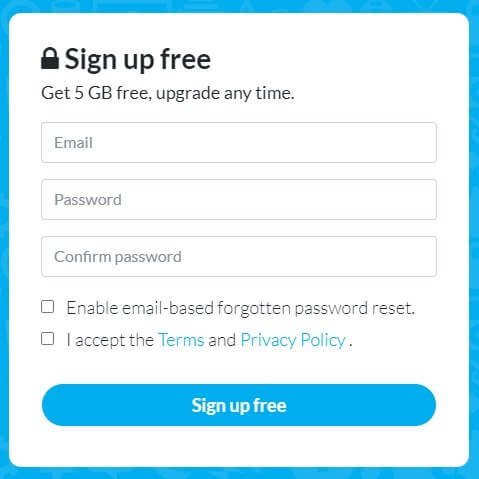
Once you signup with the basic details, Sync.com will ask you to download the desktop client. It will automatically detect the operating system that you are using. You can also skip the download option and head for the web panel straightaway.
Here is what you will see:
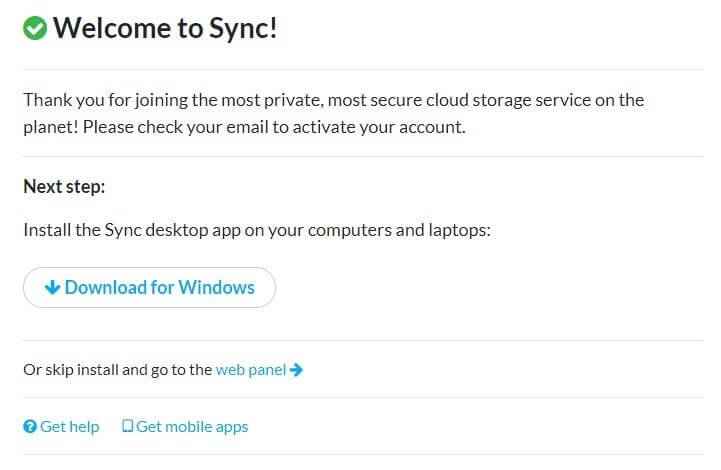
Working with cloud storage becomes easy if you download and install the desktop app. I will recommend that you do install it on your desktop or your laptop.
The installer file is 58.9 MB in size. It should not take more than a few seconds for the download to complete. Unfortunately, when I started downloading it, it took eons to download. I don’t know why that happened, but I did test my internet speed and found it to be clocking 81.16 Mbps download speed!

Maybe there was some issue with the download server. Nonetheless, it eventually downloaded after 24 minutes. In between, I enjoyed a cup of hot tea and some biscuits.
Once the installer file finished downloading, all I had to do was double-click on the installer file, and it started installing. In between, it asked me to either create a new account or use an existing account.
Since I created a new account on the Sync.com website, I used the same credentials, and it finished installing.
Once installed, I could see a Sync.com folder in my file browser. This is what it looked like:

The installer also created a system tray icon. It looks like this:

Clicking on the system tray icon pulls out a menu that gives quick access to the web interface, the recently synced files, and the settings for the desktop app. This is what I found:

Clicking on the small cog icon pulls out another menu from where I can go to Sync.com’s web panel, get access to desktop app settings (from Preferences), etc.

Clicking on the Preferences menu item gives the settings window that looks something like this:
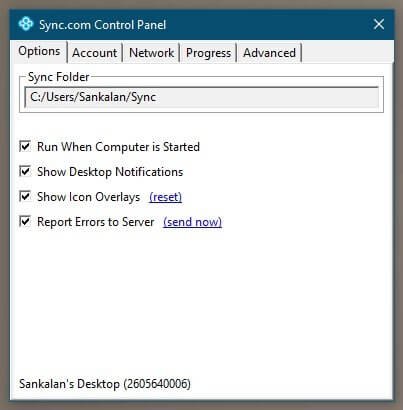
There are various tabs. The most important one is the Network tab from where you can set the upload and download speed. The default is set to Automatic, but you can change it to different values from the available options in the dropdown. This is what I mean:
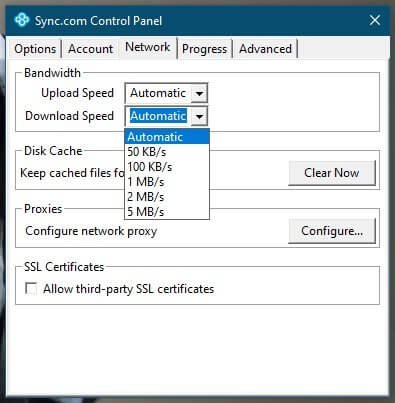
Don’t worry about any other setting if you are a rookie and you don’t know a damn thing about network proxy or SSL certificates. I just leave the default settings.
Working Around with Sync Folder
The Sync folder is like any normal folder on your computer. You can create new folders within the folder or simply save files within that main Sync folder. Anything that you put in that folder will be synced to the Sync.com server.
You can access those files and folders directly from the web panel or from any other device where you installed the Sync.com app and logged in using your login credentials.
 For instance, I placed a folder named ‘James’ in the Sync folder on my desktop, and it shows the folder on the web interface. Take a look:
For instance, I placed a folder named ‘James’ in the Sync folder on my desktop, and it shows the folder on the web interface. Take a look:
That’s how easy it is.
If you want to create a sharing link, all you have to do is to right-click on a folder or a file in the Sync folder and click on the Create a Link option. This is what it looks like:
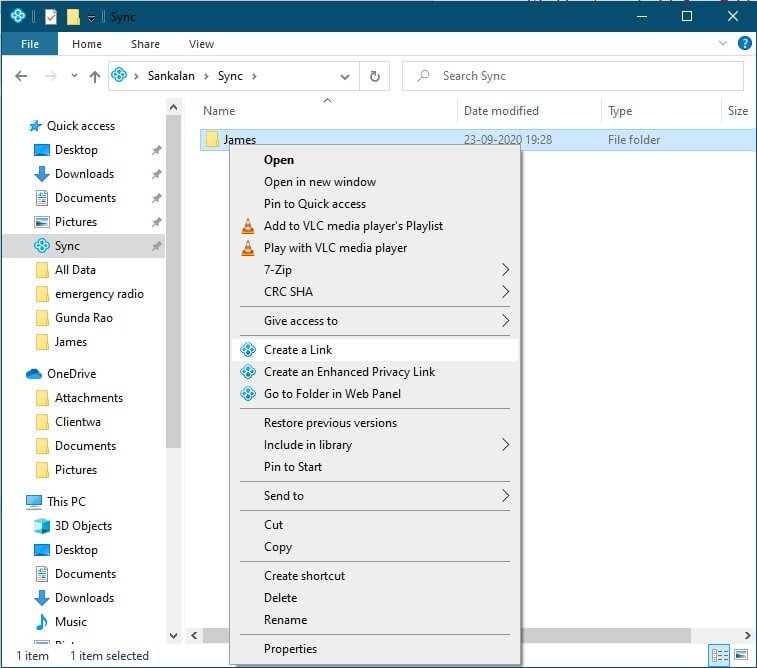
The link that you create can be accessed from the web panel. That’s somewhat ridiculous. There has to be a way to use the link directly from the desktop. But anyway, the overall feature is cool and workable.
Working with Sync Vault
Where on Earth is the Sync Vault? You won’t see that on your desktop. However, you can send any file outside of the Sync folder to the Sync Vault that you can access only from the web panel.
To send any file to the vault, all you have to do is to right-click on it and select ‘Copy to Sync Vault’ from the menu. Remember that it will work only for files and folders outside of the Sync folder.
This is what it looks like:
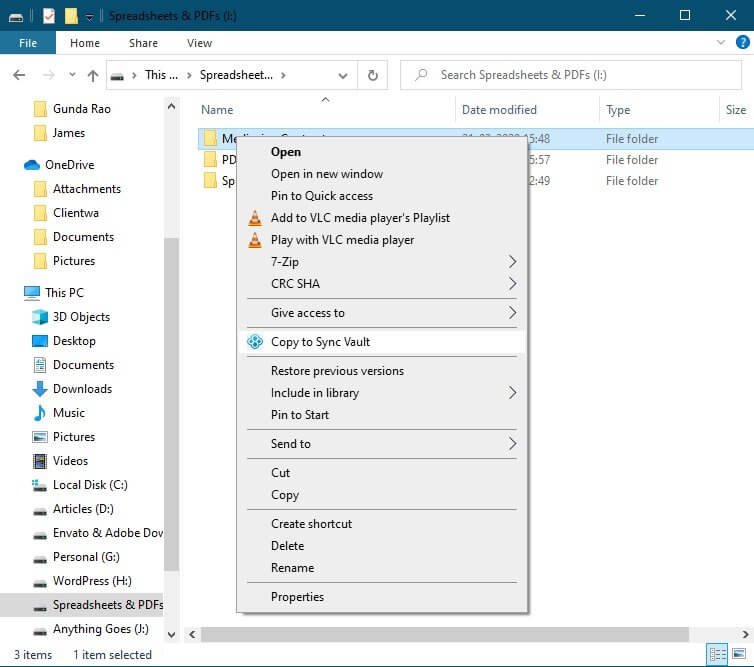
Once you click on ‘Copy to Sync Vault’, the folder or the file will show up on the web panel’s Vault page. This is what you will see on the web panel.
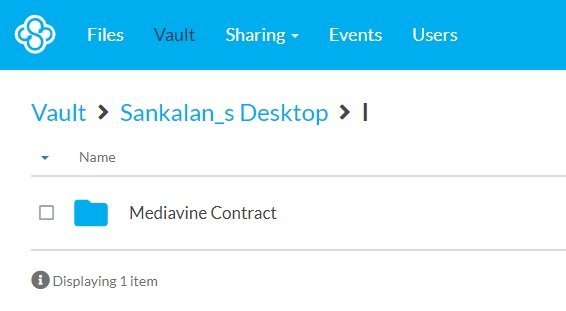
Interestingly, Sync.com will create a master folder in the Vault segment by the name of the machine or device. In my case, it is ‘Sankalan’s Desktop.’ Inside that master folder will be another folder. Inside that folder will be the folder or file that I send to the vault from my device.
That’s pretty much everything that you can do on the desktop or your device.
Working with the Web Panel
The web panel is pretty neat. Here is what it looks like:
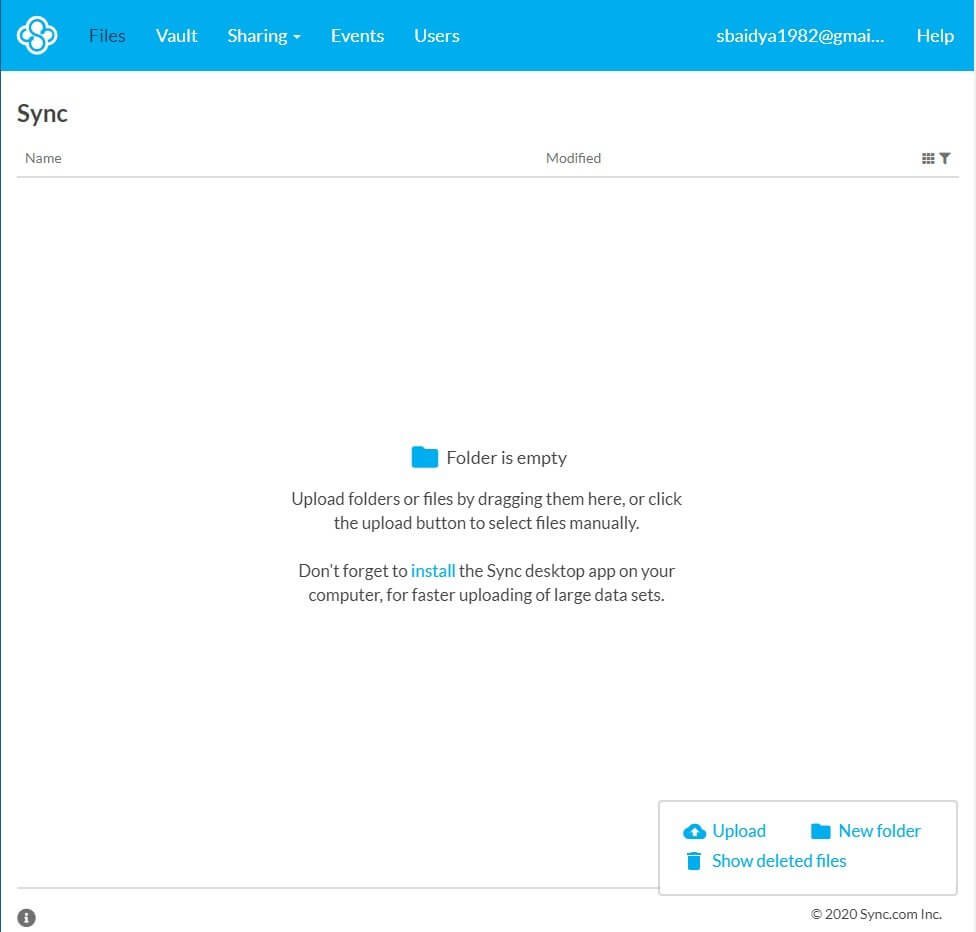
On the web panel, you will get an option to increase your storage size by performing various tasks. On a big screen, you will see this option:
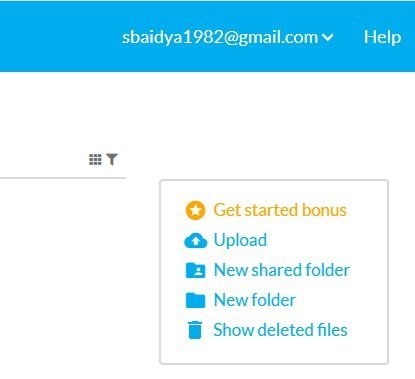
Once you click on the “Get started bonus” link, you will find this:
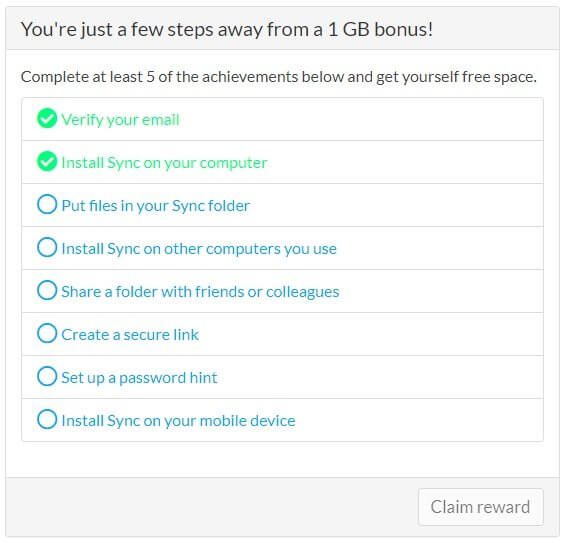
Once you have completed at least 5 of the tasks, you will get a 1 GB bonus. If you want to get more space (up to 20 GB), you have to refer new users to the company.
Getting back to the main interface, you can see tabs neatly arranged on the homepage of the panel. This is what it looks like:

The primary tab is the Files tab, where you will see all files that you put in the Sync folder on your device.
Hovering your mouse cursor to any file or folder will show the sharing button, clicking on which will give you the option to share the file or folder as a link, or you can invite others for collaboration.
You can also create new folders or upload files directly into the web interface from the options you can see on the right side of the screen.
Moving on to the Vault tab, you can see all files that you don’t want to put in the Sync Vault, but want to keep them on the Sync.com server for easy access from the web.
This is how the Vault tab looks like:

The Sharing tab will show you the list of all links that you have generated from your device or from the web panel for sharing with others.
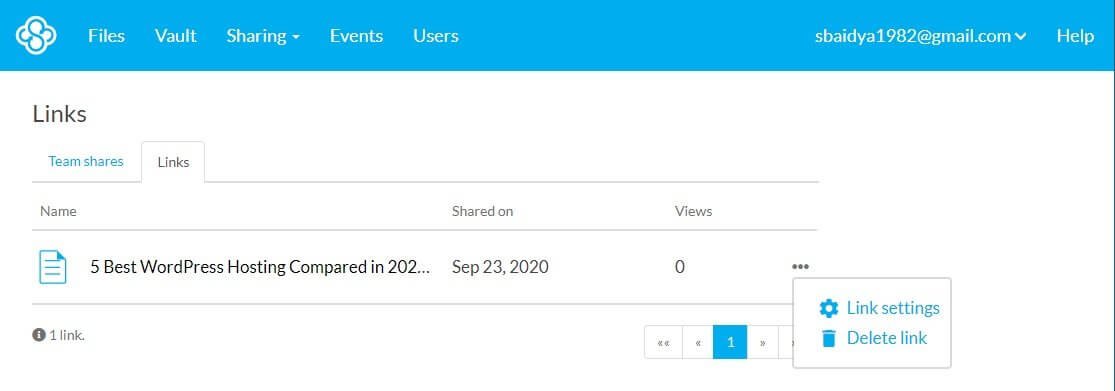
You can also define different settings for each link or simply delete the links.
Certain link settings options will be available only after you upgrade to a paid plan. Here is what you get for free and what you can get after you upgrade:
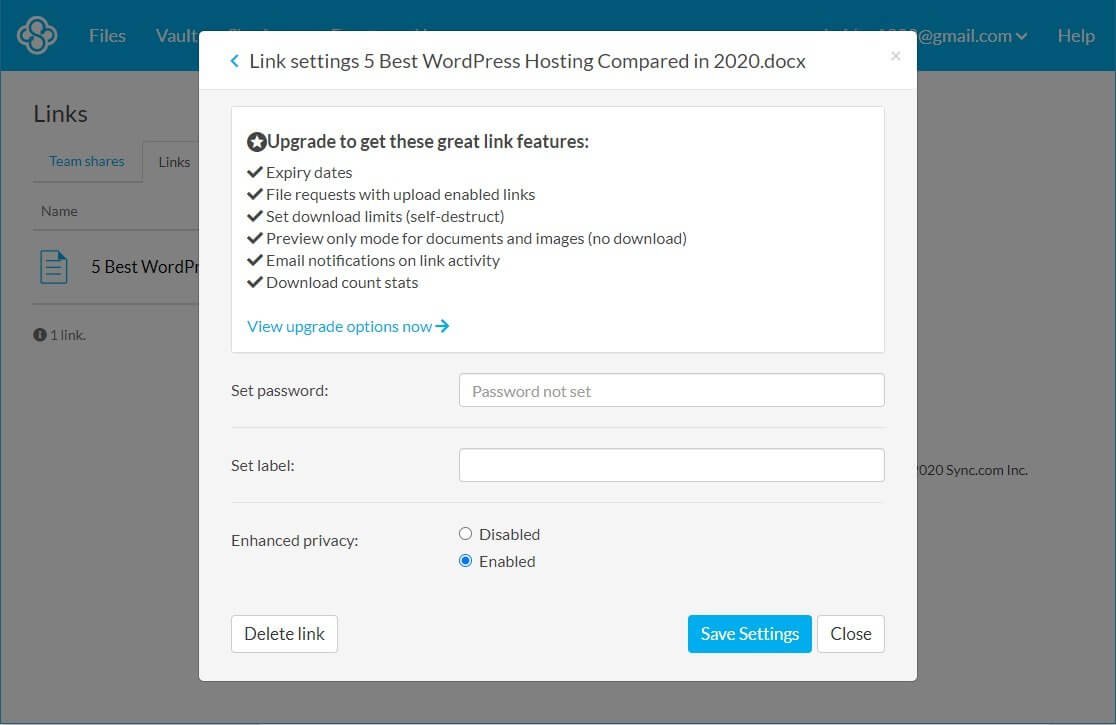
The Events tab will show you all activities that you performed on our Sync.com account. The Users tab will allow you to add new users. However, remember that if you want to use new users, you have to upgrade to a premium plan (a team plan).
To get the version history, you have to navigate to individual files within a folder in the Files tab and click on the three dots (ellipses) you see next to each file. The version history option will be available in the menu that opens up. This is what it looks like:
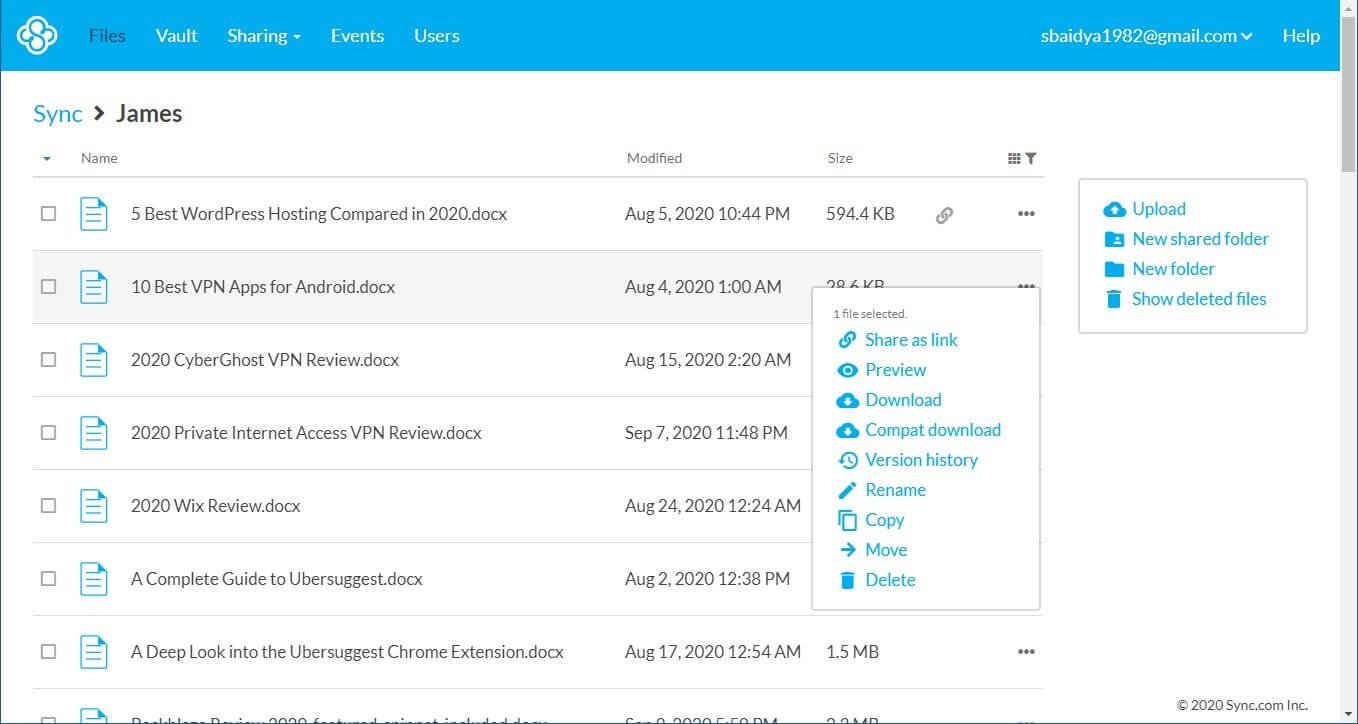
The Compact download option that you see on the menu is a compatibility mode that Sync.com uses to download a file through a browser that will not support on-the-fly decryption locally. All browsers will support Compact download.
If you click on the Download button, the file will be decrypted on-the-fly locally only by supported browsers. Chrome, Firefox, Microsoft Edge, and Internet Explorer will support this. Safari and some mobile browsers will not support this.
Finally, you can access the account-level settings from the top right-hand corner by clicking on the email ID. This is what you will see:
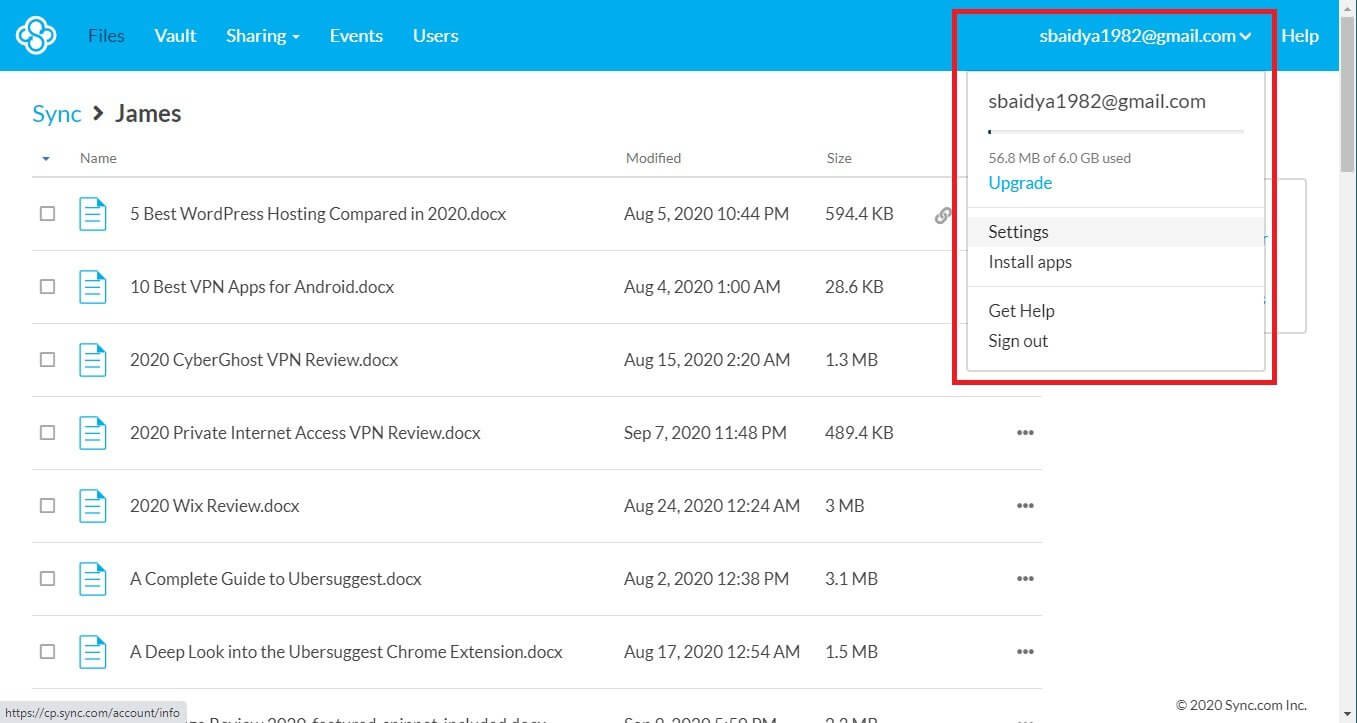
I am pretty sure that you are smart enough to figure out the settings there. I don’t need to spoon-feed those things to you.
If you want to enable two-factor authentication, you can do that from the Security tab under settings. This is what you will see:
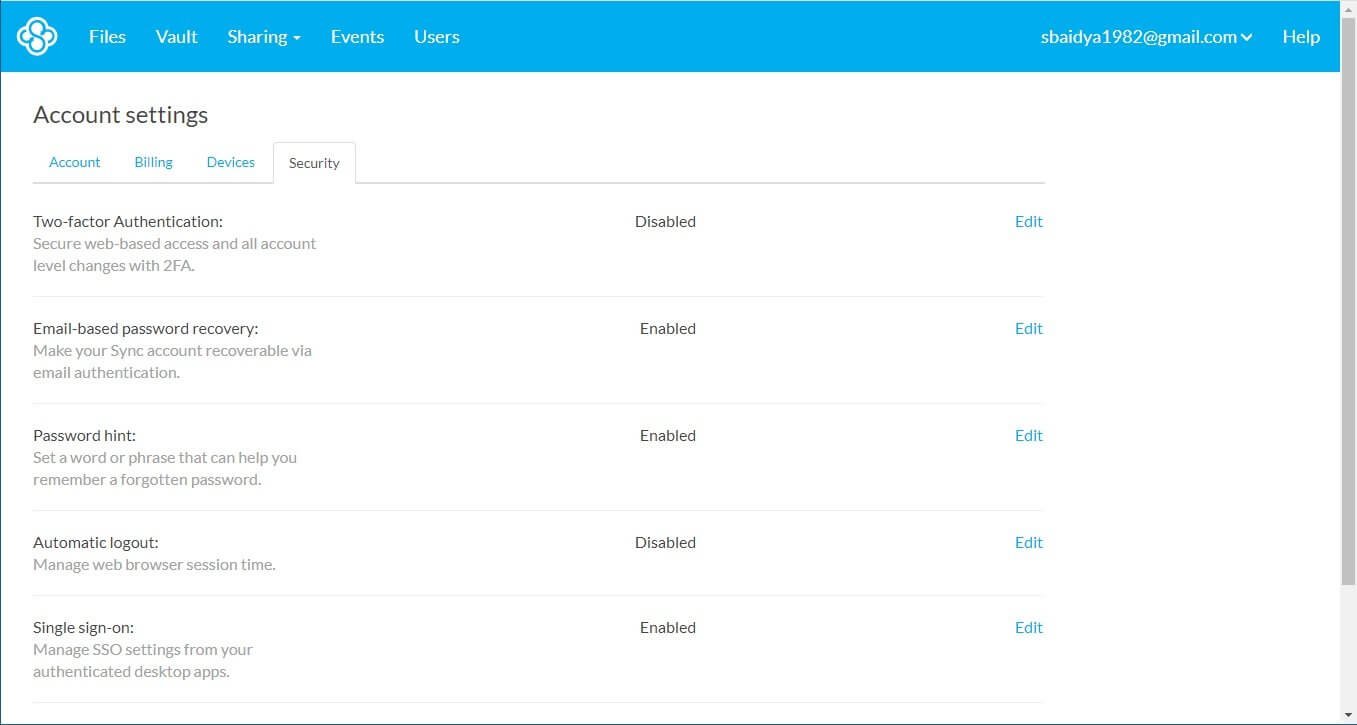
Working with the Mobile App
Working with Sync.com’s mobile app is very simple. You need to download the app from the Play Store or App Store. Once you download and install the app, it will ask you to log in. This is what you will see:
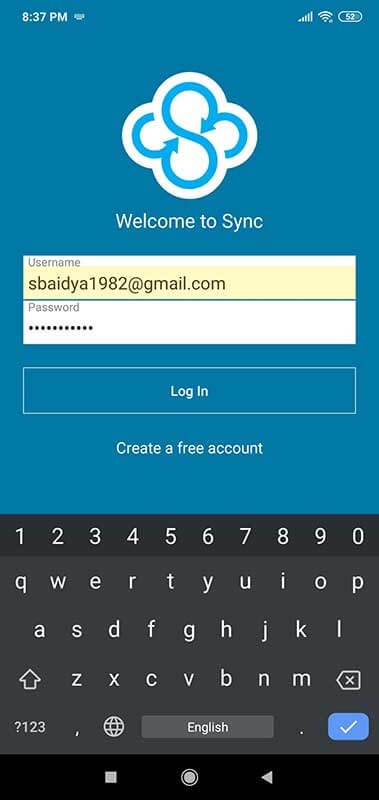
Once you log in, the first thing you will see is the menu. This is what you will see.
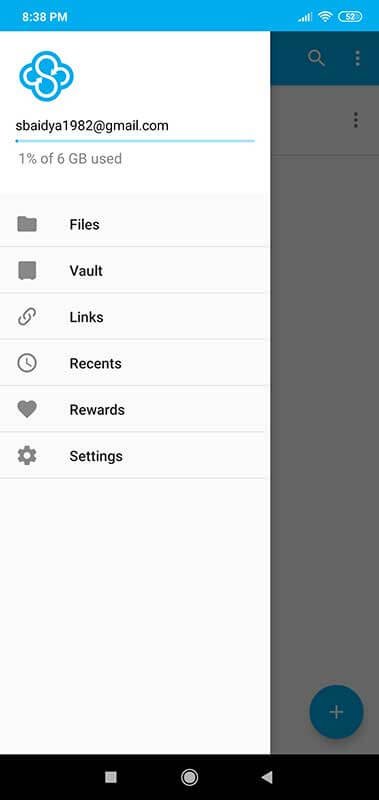
The folder structure is the same as you find on the web portal. You can see the Vault option as well and download the files from the vault.

In the settings screen, you can lock the app with a passcode and even enable uploading media files directly from your camera.
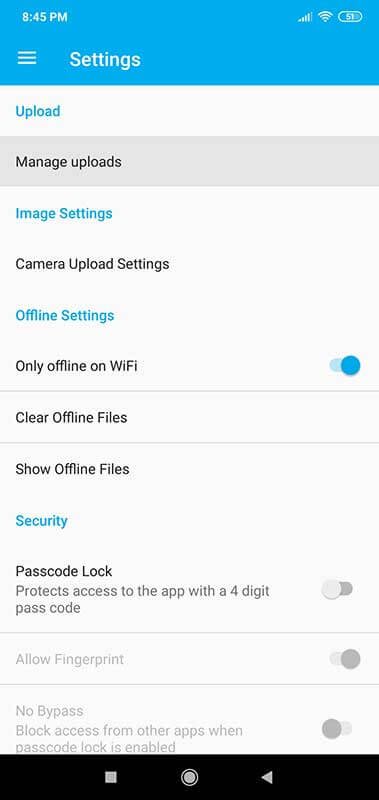
Overall, the mobile app interface is clean and easy to navigate.
Things I Didn’t Like About Sync.com
I did mention earlier that the overall interface of Sync.com needs some improvement. There are some other problems that Sync.com should address. Here is what I don’t link about Sync.com:
No Drag and Drop
If you want to rearrange your folders and files and move them into a new folder, you cannot drag and drop them. You have to access the Move option from the ellipses menu (three dots) next to each folder or file and then click around to move.

That’s annoying. Services like Dropbox, OneDrive, etc. allow drag-and-drop feature, which arguably is the easiest way.
Also, if you want to drop a file or folder into a subfolder, you have to have that subfolder visibly open before you move it! That’s annoying, to say the least.
Slow Speed
The speeds for upload and download are slow. With an 85 Mbps connection, it took me 40 minutes to upload a file of 1GB. That’s way more than what pCloud takes. The reason for this slow speed is that the files are encrypted on-the-fly.
Download was considerably faster, with 1 GB file taking around 17 minutes to download. Still, that was slower than the download speed of pCloud. Again, the slow speed is caused by on-the-fly decryption.
That’s the cost that you have to pay.
No Random Folder Syncing
If you want to sync a random folder from your desktop to Sync.com, you cannot do that without dragging that folder into the Sync folder on your desktop. So, you need to dump everything in a single folder for them to sync.
This can lead to space crunch, especially because Sync.com’s desktop client will get installed in the C Drive.
You can get around this problem by putting files and folder in the Sync Vault.
No Linux Support
Unfortunately, Sync.com has no support for Linux. Sync.com has put Linux support in its roadmap, but when exactly that’s going to happen is not known. Linux users can, however, use the web interface to use Sync.com.
No Live Chat or Phone Support
One of the pressing concerns is that Sync.com will not give you the option of live chat or phone support. This means that if you need some help, you have to either go through their knowledge base, or you have to send them an email.
To send an email, you need to click the help button from the web panel. This is what it looks like:
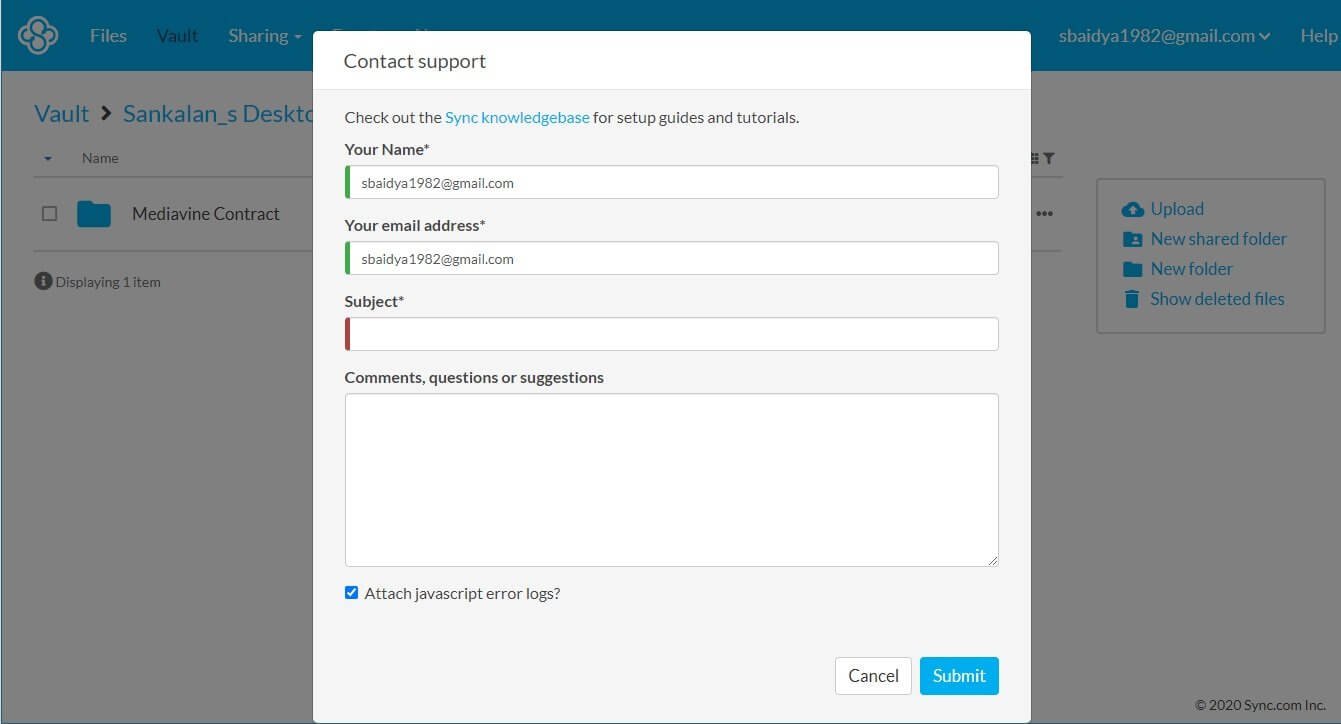
If you click on the help button from the settings menu from the system tray icon of your desktop, it will land you to the knowledge base of Sync.com.
No File Editing Option
Unlike Google Drive or OneDrive or even Dropbox, you cannot edit files from the web interface. You can preview files, though. This lack of collaboration features is not ideal for those who are looking for cloud storage with many collaboration facilities.
Since Sync.com allows zero-knowledge encryption, it cannot offer too many collaboration features. That’s the price you have to pay.
Conclusion
Do I recommend Sync.com? Of course, I do! As I said, if collaboration is your primary agenda, Sync.com is never a good option. If privacy is what you seek, there is no better option than Sync.com.
Since I am not much of a collaboration guy (I work solo – I am a lone warrior), Sync.com works perfectly fine for me. Its zero-knowledge encryption is what I fall for. Yes, it has some shortcomings, but I can make peace with them. Finally, the choice is yours!

